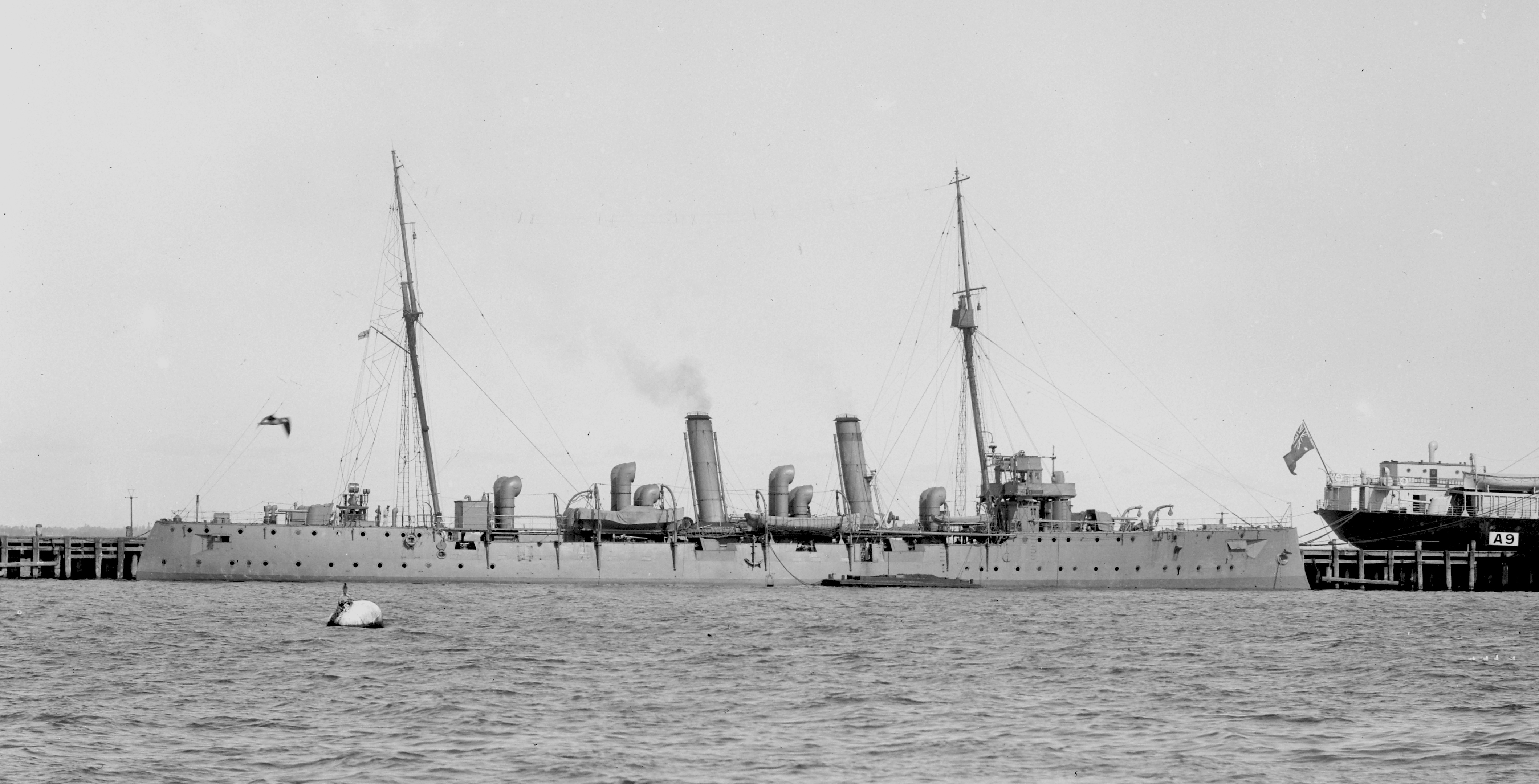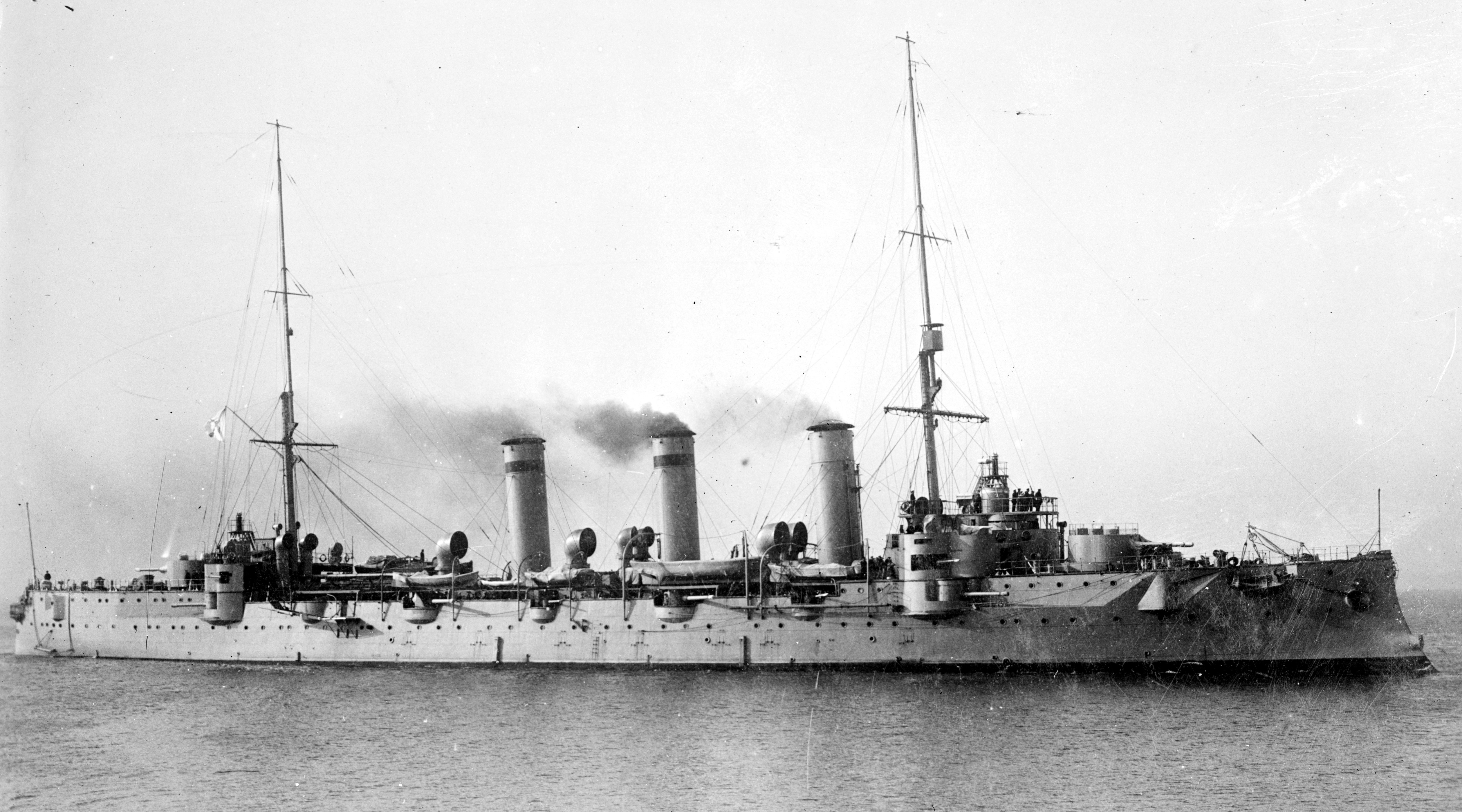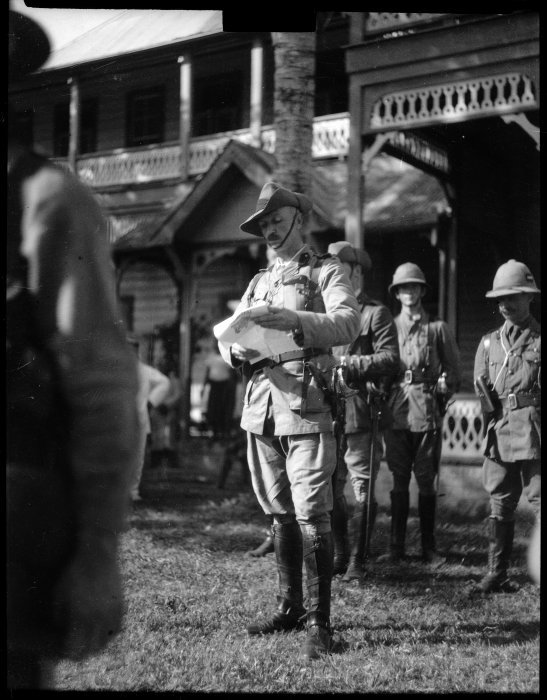|
HMS Pyramus (1897)
HMS ''Pyramus'' was a protected cruiser of the Royal Navy. There were eleven "Third class" protected cruisers in the class, which was designed by Sir William White. While well armed for their size, they were primarily workhorses for the overseas fleet on "police" duties and did not serve with the main battlefleet. They displaced 2,135 tons, had a crew complement of 224 men and were armed with eight QF 4 inch (102 mm, 25 pounder) guns, eight 3-pounder guns, three machine guns, and two 18 inch (457 mm) torpedo tubes. With reciprocating triple expansion engines and a variety of boilers, the top speed was . HMS ''Pyramus'' was laid down at Palmers Shipbuilding and Iron Company, Jarrow in May 1896, and launched on 15 May 1897. She served in various colonial posts, including in the Mediterranean Fleet in 1901–02. Commander Alfred Ernest Albert Grant was appointed in command on 2 August 1901. In October 1902 she was reported to be visiting Suda ... [...More Info...] [...Related Items...] OR: [Wikipedia] [Google] [Baidu] |
Palmers Shipbuilding And Iron Company
Palmers Shipbuilding and Iron Company Limited, often referred to simply as "Palmers", was a United Kingdom of Great Britain and Ireland, British shipbuilder, shipbuilding company. The Company was based in Jarrow, County Durham, in north-eastern England, and also had operations in Hebburn and Willington Quay on the River Tyne. History Early history and growth The company was established in 1852 by Sir Charles Palmer, 1st Baronet, Charles Mark Palmer as Palmer Brothers & Co. in Jarrow. Later that year it launched the ''John Bowes (Steamship), John Bowes'', the first Screw steamer, iron screw Collier (ship type), collier. By 1900 the business was known as Palmers Shipbuilding and Iron Company. At that time, besides building ships, it manufactured and processed its own steel and other metals, and its products included Reed water tube boilers and marine steam engines. By 1902 Palmers' base at Jarrow occupied about 100 acres (41 hectares) and included 0.75 miles (1.2&n ... [...More Info...] [...Related Items...] OR: [Wikipedia] [Google] [Baidu] |
Protected Cruiser
Protected cruisers, a type of naval cruiser of the late-19th century, gained their description because an armoured deck offered protection for vital machine-spaces from fragments caused by shells exploding above them. Protected cruisers resembled armored cruisers, which had in addition a belt of armour along the sides. Evolution From the late 1850s, navies began to replace their fleets of wooden ships-of-the-line with armoured ironclad warships. However, the frigates and sloops which performed the missions of scouting, commerce raiding and trade protection remained unarmoured. For several decades, it proved difficult to design a ship which had a meaningful amount of protective armour but at the same time maintained the speed and range required of a "cruising warship". The first attempts to do so, armored cruisers like , proved unsatisfactory, generally lacking enough speed for their cruiser role. During the 1870s the increasing power of armour-piercing shells made armou ... [...More Info...] [...Related Items...] OR: [Wikipedia] [Google] [Baidu] |
Occupation Of German Samoa
The Occupation of Samoa was the takeover – and subsequent administration – of the Pacific colony of German Samoa by New Zealand during World War I. It started in late August 1914 with landings by the Samoa Expeditionary Force from New Zealand. The landings were unopposed and the New Zealanders took possession of Samoa for the New Zealand Government on behalf of King George V. The Samoa Expeditionary Force remained in the country until 1915, while its commander, Colonel Robert Logan, continued to administer Samoa on behalf of the New Zealand Government until 1919. The takeover of Samoa was New Zealand's first military action in World War I. Background Upon the outbreak of World War I on 5 August, the New Zealand Government authorised the raising of the New Zealand Expeditionary Force (NZEF) for service in the war. Mobilisation for the war had already begun, with preparations discreetly beginning a few days prior. The day after the declaration of war, the British Government r ... [...More Info...] [...Related Items...] OR: [Wikipedia] [Google] [Baidu] |
New Zealand Force South East Asia
New Zealand Force South East Asia (NZFORSEA) (1974–1989) comprised the elements of the Royal New Zealand Navy, New Zealand Army and Royal New Zealand Air Force. Much of the New Zealand military left Singapore as part of operation Kupe in 1989, leaving behind a residual Defence Support Unit (NZDSU). Background Although New Zealand has had a military presence in South East Asia for most of the post WWII period, it was not until the disestablishment of the ANZUK Force in 1974, comprising Australian, New Zealand and United Kingdom military personnel, that New Zealand established a self-supporting national presence in the region. Formally established on 30 January 1974, NZFORSEA was under the direct command of Ministry of Defence in New Zealand. Although NZFORSEA was based in Singapore, its normal area of operation, the territories of Malaysia and Singapore, was identical with its predecessor, the ANZUK Force. Administrative arrangements and function The ANZUK Force operated ... [...More Info...] [...Related Items...] OR: [Wikipedia] [Google] [Baidu] |
1914
This year saw the beginning of what became known as World War I, after Archduke Franz Ferdinand of Austria, heir to the Austrian throne was Assassination of Archduke Franz Ferdinand, assassinated by Serbian nationalist Gavrilo Princip. It also saw the first airline to provide scheduled regular commercial passenger services with heavier-than-air aircraft, with the St. Petersburg–Tampa Airboat Line. Events January * January 1 – The St. Petersburg–Tampa Airboat Line in the United States starts services between St. Petersburg, Florida, St. Petersburg and Tampa, Florida, becoming the first airline to provide scheduled regular commercial passenger services with heavier-than-air aircraft, with Tony Jannus (the first federally-licensed pilot) conveying passengers in a Benoist XIV flying boat. Abram C. Pheil, mayor of St. Petersburg, is the first airline passenger, and over 3,000 people witness the first departure. * January 11 – The Sakurajima volcano in Japan b ... [...More Info...] [...Related Items...] OR: [Wikipedia] [Google] [Baidu] |
Crete
Crete ( el, Κρήτη, translit=, Modern: , Ancient: ) is the largest and most populous of the Greek islands, the 88th largest island in the world and the fifth largest island in the Mediterranean Sea, after Sicily, Sardinia, Cyprus, and Corsica. Crete rests about south of the Greek mainland, and about southwest of Anatolia. Crete has an area of and a coastline of 1,046 km (650 mi). It bounds the southern border of the Aegean Sea, with the Sea of Crete (or North Cretan Sea) to the north and the Libyan Sea (or South Cretan Sea) to the south. Crete and a number of islands and islets that surround it constitute the Region of Crete ( el, Περιφέρεια Κρήτης, links=no), which is the southernmost of the 13 top-level administrative units of Greece, and the fifth most populous of Greece's regions. Its capital and largest city is Heraklion, on the north shore of the island. , the region had a population of 636,504. The Dodecanese are located to the no ... [...More Info...] [...Related Items...] OR: [Wikipedia] [Google] [Baidu] |
Suda Bay
Souda Bay is a bay and natural harbour near the town of Souda on the northwest coast of the Greek island of Crete. The bay is about 15 km long and only two to four km wide, and a deep natural harbour. It is formed between the Akrotiri peninsula and Cape Drapano, and runs west to east. The bay is overlooked on both sides by hills, with a relatively low and narrow isthmus in the west near Chania. Near the mouth of Souda bay, between the Akrotiri and the town of Kalives, there is a group of small islands with Venetian fortifications. The largest island is Souda Island, giving its name to the bay. Souda Bay is now a popular tourist destination although there are no formal public beaches designed in the area, due to the presence of the Crete Naval Base, a major naval installation of the Hellenic Navy and NATO in the eastern Mediterranean. Villages such as Megala Chorafia and Kalives afford fine views of the bay, and house-building, particularly for foreigners and tourist co ... [...More Info...] [...Related Items...] OR: [Wikipedia] [Google] [Baidu] |
1902
Events January * January 1 ** The Nurses Registration Act 1901 comes into effect in New Zealand, making it the first country in the world to require state registration of nurses. On January 10, Ellen Dougherty becomes the world's first registered nurse. ** Nathan Stubblefield demonstrates his wireless telephone device in Kentucky, United States. * January 8 – A train collision in the New York Central Railroad's Park Avenue Tunnel kills 17 people, injures 38, and leads to increased demand for electric trains and the banning of steam locomotives in New York City. * January 23 – Hakkōda Mountains incident: A snowstorm in the Hakkōda Mountains of northern Honshu, Japan, kills 199 during a military training exercise. * January 30 – The Anglo-Japanese Alliance is signed. February * February 11 – Police and universal suffrage demonstrators are involved in a physical altercation in Brussels, Belgium. * February 15 – The Berlin U-B ... [...More Info...] [...Related Items...] OR: [Wikipedia] [Google] [Baidu] |
Alfred Ernest Albert Grant
Admiral (Royal Navy), Admiral Alfred Ernest Albert Grant (10 April 1861 – 14 August 1933) was a Royal Navy officer. During the First World War, he played an important role in shipbuilding. Grant was the sixth son of John Glasgow Grant, CMG, sometime Speaker of the House of Assembly of Barbados. He entered HMS ''Britannia'' as a colonial cadet in 1874, and took part in the Anglo-Egyptian War of 1882. References External links * {{NPG name, 75212, Alfred Ernest Albert Grant 1861 births 1933 deaths Royal Navy admirals Royal Navy admirals of World War I Royal Navy personnel of the Anglo-Egyptian War Royal Navy personnel of the Second Boer War Recipients of the Navy Distinguished Service Medal ... [...More Info...] [...Related Items...] OR: [Wikipedia] [Google] [Baidu] |
Mediterranean Fleet
The British Mediterranean Fleet, also known as the Mediterranean Station, was a formation of the Royal Navy. The Fleet was one of the most prestigious commands in the navy for the majority of its history, defending the vital sea link between the United Kingdom and the majority of the British Empire in the Eastern Hemisphere. The first Commander-in-Chief for the Mediterranean Fleet was the appointment of General at Sea Robert Blake in September 1654 (styled as Commander of the Mediterranean Fleet). The Fleet was in existence until 1967. Pre-Second World War The Royal Navy gained a foothold in the Mediterranean Sea when Gibraltar was captured by the British in 1704 during the War of Spanish Succession, and formally allocated to Britain in the 1713 Treaty of Utrecht. Though the British had maintained a naval presence in the Mediterranean before, the capture of Gibraltar allowed the British to establish their first naval base there. The British also used Port Mahon, on the isla ... [...More Info...] [...Related Items...] OR: [Wikipedia] [Google] [Baidu] |
Torpedo Tube
A torpedo tube is a cylindrical device for launching torpedoes. There are two main types of torpedo tube: underwater tubes fitted to submarines and some surface ships, and deck-mounted units (also referred to as torpedo launchers) installed aboard surface vessels. Deck-mounted torpedo launchers are usually designed for a specific type of torpedo, while submarine torpedo tubes are general-purpose launchers, and are often also capable of deploying naval mine, mines and cruise missiles. Most modern launchers are standardized on a diameter for light torpedoes (deck mounted aboard ship) or a diameter for heavy torpedoes (underwater tubes), although other sizes of torpedo tube have been used: see Torpedo#Classes and diameters, Torpedo classes and diameters. Submarine torpedo tube A submarine torpedo tube is a more complex mechanism than a torpedo tube on a surface ship, because the tube has to accomplish the function of moving the torpedo from the normal atmospheric pressure within t ... [...More Info...] [...Related Items...] OR: [Wikipedia] [Google] [Baidu] |
QF 3-pounder Hotchkiss
The QF 3-pounder Hotchkiss or in French use Canon Hotchkiss à tir rapide de 47 mm were a family of long-lived light naval guns introduced in 1886 to defend against new, small and fast vessels such as torpedo boats and later submarines. There were many variants produced, often under license which ranged in length from 32 to 50 calibers but 40 caliber was the most common version. They were widely used by the navies of a number of nations and often used by both sides in a conflict. They were also used ashore as coastal defense guns and later as an anti-aircraft gun, whether on improvised or specialized HA/LA mounts. Operational history French service The French Navy used two versions of the Hotchkiss 3-pounder: the short-barreled M1885 and the long-barreled M1902, which had a larger muzzle velocity than its predecessor. The French L/40 M1885 and the British QF 3-pounder were largely the same gun. Like the British who paired their 3-pounders with the larger QF 6-poun ... [...More Info...] [...Related Items...] OR: [Wikipedia] [Google] [Baidu] |








